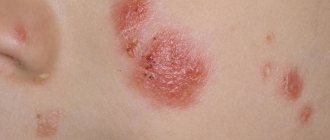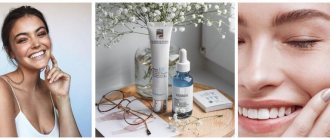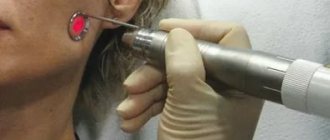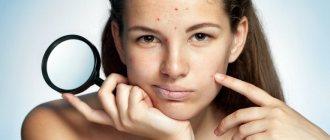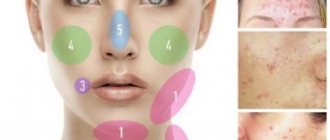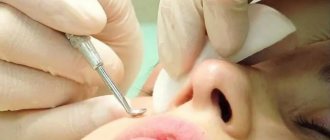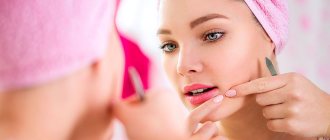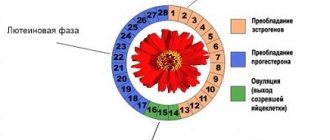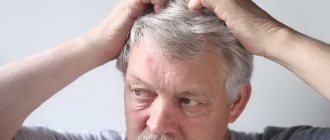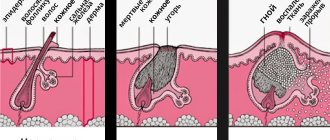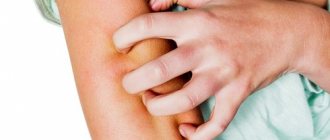Despite modern hygiene, inflamed acne on the face is not uncommon today. The reason for this is, among other things, poor nutritional culture or its complete absence.
Such pimples should not be ignored; it is better to take proper measures to eliminate them, especially if there are a lot of them.
Causes
The appearance of inflamed acne on the skin is often associated with blockage of the sebaceous ducts. Normal functioning of the skin pores ensures hydration of the epidermis and protects against adverse effects.
Sometimes the balance is upset:
- sebum closes the ducts;
- bringing the secret out becomes impossible;
- it accumulates inside the skin;
- a nutrient medium is formed for the growth and reproduction of bacteria.
To fight pathogenic microorganisms, the body sends a large number of leukocytes to the inflammatory focus, resulting in pus.
But, since the duct is blocked, the outflow of pus is impossible, the follicle expands, and an inflamed tubercle in the form of a red pimple forms on the skin. Many provoking factors can aggravate the process; they are different at different ages.
In a baby
Neonatal pustulosis occurs in infants immediately after birth or in the first month of life. Sometimes it happens 3-4 months after birth and very rarely – after 8-12 months.
This is not considered a disease; the problem is of a natural physiological nature and goes away on its own after the adaptation period has passed.
Causes:
- establishing hormonal processes in the body;
- adaptation of the skin to environmental conditions.
The influence of the maternal hormone estrogen on the baby’s body lasts for several months. Subsequently, the hormonal levels of the infant normalize and remain stable until adolescence.
Adaptive processes of the skin to adapt to the air environment also occur quickly. At this time, increased sebum production is considered natural and does not require treatment.
In adults
The appearance of inflamed rashes in adulthood depends on many conditions. It is often impossible to find out on your own why rashes appear. To do this, you need to contact a dermatologist or cosmetologist.
Provoking factors:
- damage to the skin epidermis by infection;
- frostbite or overheating of the skin;
- weakening of the immune barrier;
- hormonal imbalance;
- constant stressful situations;
- long-term use of certain medications;
- poor nutrition;
- use of low-quality cosmetics;
- insufficient facial skin care.
In women, inflamed acne on the face can appear due to gynecological diseases, disruption of the ovaries, appendages, and also before menstruation.
Rashes are sometimes associated with problems with the thyroid gland, intestines, stomach, and impaired kidney function.
Acne is a consequence of skin diseases, the presence of subcutaneous mites. Therefore, it is important to have an experienced specialist determine why acne appears.
Teenagers have red ones
Most often, teenage acne is reddish-pink in color and appears as a result of hormonal fluctuations. They are associated with puberty.
At this time, the production of female and male sex hormones increases, which provoke the active work of the sebaceous glands.
Other reasons:
- hereditary predisposition to oily skin;
- consumption of sweets, fast food, carbonated drinks;
- insufficient intake of microelements from food;
- excessive passion for cosmetic drying products.
Sometimes the appearance of inflamed pimples on the face is promoted by an unsuccessful cosmetic procedure at home or an attempt to squeeze out a purulent pimple on your own. Any doctor will tell you that this cannot be done.
For professional facial cleansing, you need to go to a beauty salon. It’s a good idea to use folk remedies to eliminate inflammation and dry skin.
Types of acne
Acne is a common skin rash, also called pimples. In medicine, there are other terms - acne vulgaris, acne. They are formed due to inflammatory processes of the sebaceous glands, which disrupts the process of sebum secretion onto the surface of the skin.
Often the disease appears as a consequence of other pathologies. For example, pink and red pimples may be associated with liver disease. If a pink rash appears on the forehead, there are problems with the digestive organs. Whiteheads on the eyelids indicate kidney disease. A rash near the nose and lips indicates cardiovascular pathologies. And if acne is noticed on the chin, you need to check the ovaries for the presence of a cyst.
There are several types of acne. One of the common classifications looks like this.
Whiteheads
These rashes are called differently: there are names such as millet or milia. They accumulate under the skin and represent dead cells. Mainly spread over the surface of the eyelids and cheeks. They appear in small quantities, but there are also clusters of several blackheads in the form of fairly hard particles.
Purulent acne
This type of rash is painful. They appear on the face, back and scalp. Depending on the appearance and causes of appearance, several types are distinguished:
- A pustule is a red acne filled with pus.
- Papule is a reddish ball.
- Nodule - formed as a result of inflammation of the deep layers.
- The cyst is a bluish eel that produces noticeable pain when pressed.
Rosacea
This type of rash appears against the background of chronic dermatosis. The main reason is disruption of processes in the sebaceous glands, damage to hair follicles and blood vessels (capillaries). Requires mandatory diagnosis by a dermatologist (bacteriological culture selection). The disease develops against the background of alcohol abuse, spicy and spicy foods, as well as smoking.
Acne vulgaris
This type of rash appears due to a staph infection. First, small black dots (comedones) appear on the face. After this, when pressing on the affected area, pain is felt, and the inflammatory process itself becomes more active. Wounds form, after which they can leave scars.
How to quickly hide?
Under certain circumstances, it is necessary to quickly eliminate red inflammation on the face. Some effective methods are used for this.
The most effective are considered:
- lotions with furatsilin solution;
- applying a piece of ice to the inflamed area;
- rubbing with apple cider vinegar;
- treatment with lemon or grapefruit juice.
The use of 5% iodine tincture helps to quickly relieve inflammation. It is better to treat with iodine at night. By morning, iodine will be completely absorbed into the skin, the epidermis will dry out, and inflammation will decrease.
Before using the lotions, the product should be cooled and then applied to a cotton pad. The inflamed pimple should be burned for several minutes. The next morning the redness will decrease, the amount of inflammation will decrease.
Video: Treatment of boils
On the face
Treatment of acne on the face should be carried out under medical supervision.
This is due to the fact that some types of acne, if not treated correctly, can leave keloid scars, which is an unpleasant cosmetic defect.
After establishing the cause, therapy is prescribed using the following types of ointments:
- Zenerite. The main active ingredient is Erythromycin (a broad-spectrum antibiotic). Destroys streptococci, and the zinc included in its composition normalizes the functioning of the sebaceous glands. Particularly effective against black and white comedones (can be used for lesions over a large area).
- Salicylic ointment. It has a pronounced antiseptic effect, as a result of which it relieves the process of inflammation. Promotes positive dynamics in purulent skin rashes.
- Sulfuric ointment. The precipitated sulfur contained in the composition creates an antimicrobial effect and has a drying effect. The product is effective against subcutaneous acne.
- Syntomycin ointment. It eliminates pustular lesions and acne well.
Ointments are prescribed 2 to 1 times a day, and applied to cleansed facial skin.
The use of gels is based on the fact that they quickly penetrate through the skin pores and provide a quick therapeutic effect.
In the pharmacy network you can purchase:
- Effezel. Helps even with advanced forms of skin rashes.
- Dalatsin. The therapeutic effect is provided by the main ingredient Clindamycin.
- Metrogil. Mainly used for the treatment of red acne.
To maintain the therapeutic effect, it is sufficient to use the gel once a day.
As an additional remedy, medicinal creams and special face masks have recently been widely used.
Most often prescribed:
- Differin cream. Used to treat comedones. Can be used as a prophylactic.
- Baziron. Has a double effect. Destroys bacterial microflora and restores normal sebum secretion, moisturizing the epidermal layer of the skin.
- Keraknil mask. The composition includes clay, saturated polyhydroxy acids and wax particles. When used 3 times a week, skin pores are cleansed, ulcers are eliminated, and acne disappears.
On the body
The appearance of rashes on the body requires an integrated approach to the treatment process.
For this purpose, antibacterial drugs are prescribed:
- Benzene peroxide derivatives. Provide oxygen access, moisturize the skin surface, and relieve inflammation symptoms. Baziron AS is especially effective.
- Drugs of the Clindamycin group. They are used in long courses and have a pronounced bacteriostatic effect (Zerkalin, Klindovit, Dalatsin).
- Erythromycin and its analogues (Zinerit).
Dosage forms based on Azelaic acid. Prescribed in all cases where the etiology of acne is a bacterial pathogen.
Main drugs:
- Azelik.
- Azogel.
- Skinoren.
To normalize oily skin, synthetic analogs of vitamins A (retinoids) are prescribed.
They are highly effective against any form of acne. But they can cause side effects, and the presence of a large number of contraindications necessitates medical supervision.
Mainly prescribed:
- Isotretionine. Relieves the symptoms of inflammation and suppresses the activity of the sebaceous glands.
- Adapalene. Dries inflamed areas of the skin, eliminates the inflammatory process.
Additional tools you can use:
- Brewer's yeast;
- activated carbon (Sorbex or white carbon).
If acne is a consequence of an imbalance of intestinal microflora, it is allowed to use:
- Linux.
- Bifiform.
- Lactofiltrum.
If there is no effect from the use of medications, a surgical opening occurs, followed by treatment with antiseptic agents and the introduction of drainage.
Treatment of inflamed acne on the face
Traditional and homeopathic methods, antibiotic drugs, anti-inflammatory ointments from the pharmacy or prepared independently at home help to get rid of acne.
Even completely natural compositions can have side effects on the body and cause allergies. Because of this, before applying any product, a test should be carried out on the inner surface of the forearm.
Read about the causes of rosacea in newborns. The consequences of squeezing pimples on the face. More details here.
Folk remedies
Traditional recipes are often used to relieve inflammation and swelling. Plants that have an antiseptic effect are used. Decoctions and infusions are prepared from leaves, flowers, fruits, and roots. Solutions are used as lotions or compresses.
The following recipes are worth trying:
- green tea – brew the tea, let it cool, then wrap the tea leaves in a sterile gauze cloth and apply to the affected area;
- decoction of chamomile flowers - pour a tablespoon of raw material into a glass of boiling water, leave until cool, strain, wipe problem areas on the face during the day and at night;
- elecampane rhizome - a small amount of the plant should be boiled in a glass of water for 15-20 minutes, let the product cool, then moisten a cotton swab and apply to the inflamed pimple, leave for half an hour;
- parsley, plantain juice or a mixture of both - it is useful to wipe acne with a freshly squeezed solution every day to heal wounds and eliminate swelling.
Other plants also have antiseptic, wound-healing, antibacterial, anti-inflammatory effects. Among them are strawberries, calendula, celandine, St. John's wort, sage, and white lily.
Aloe juice or potato juice is an excellent treatment for pustular rashes and red acne. After using lotions, the skin dries out. To eliminate dryness, use a neutral moisturizer.
Antibiotics
If pathogenic pathogens begin to grow and multiply in the ducts of the sebaceous glands, doctors prescribe antibiotics. Treatment will be short-term if there are diseases of the digestive, endocrine system, or metabolic reactions are disturbed.
For inflamed acne, Doxycycline, Levomycetin, Erythromycin, and Lincomycin are most often used. The drugs stop the proliferation of pathogenic flora and destroy pathogens. The prescription and dosage of drug therapy is carried out by a dermatologist.
Ointments
Pharmaceutical preparations to combat acne are available in the form of creams, gels, and ointments. They contain components that reduce inflammation. What to anoint your skin to get rid of inflamed acne?
Topically used:
- gel Klenzit, Benzamycin, Isotrexin;
- cream Fucidin, Klindovit;
- ointment Levomekol, Mupirocin, Bactroban, as well as ointments with erythromycin or tetracycline.
Local application of drugs has a bactericidal or bacteriostatic effect. They suppress protein synthesis, which leads to the death of micropathogens.
Ointments are indicated for infectious inflammatory skin diseases caused by staphylococcus, less often by other flora. Used for boils, carbuncles, folliculitis, acne vulgaris.
How to get rid of acne?
Treatment of red acne on the face can be carried out in completely different ways. Only an experienced specialist can determine which methods will be effective in each specific case. Of course, it is quite possible to deal with small pimples on your own, but if your face is covered with large acne (single or continuous), it is better not to take risks and not self-medicate, otherwise you may encounter serious progressive inflammation, which will leave behind traces of post-acne (spots) pigmentation and various scars).
The following can be used to treat red acne:
- Local agents to suppress inflammation and reduce redness.
- Pharmacy drugs.
- Traditional medicine.
- Clay masks.
- Lotions.
- Medicinal herbs.
- Organization of a special diet.
- Procedures with a cosmetologist.
Most often, to achieve a lasting effect, a competent combination of several methods of influence is required.
How to treat redness?
You can reduce the severity of inflammation and the size of the red spot on the face with:
- Compress from a cool, sleepy tea bag.
- An ice cube made from chamomile or chamomile infusion.
- Rubbing a cut of an aloe leaf.
- Washing with calendula decoction.
- Ordinary cheap Chlorhexidine. It should be used for lotions.
Such simple means at hand will help cope with small reddish pimples. But they will be ineffective for large acne, and cold treatments can even contribute to the spread of such inflammation.
How to remove with pharmaceutical products?
At any pharmacy you can buy many affordable medications that can quickly eliminate the visual manifestations of red pimples on the face. An excellent positive effect will help to achieve:
- Zinc ointment. It has a good drying and mild anti-inflammatory effect.
- Sulfuric ointment. This medicine has excellent antiseptic and anti-inflammatory properties.
- Ichthyol ointment. It has an antiseptic and anti-inflammatory effect, and in addition has moderate analgesic properties.
- Vishnevsky ointment. Ideal for combating deep subcutaneous acne, it has a warming effect, eliminates inflammation, and has antimicrobial and wound-healing properties.
All of the listed ointments for acne are best used in the evening - at night. Medicines can be applied pointwise, and Vishnevsky ointment (for the treatment of deep acne) can be applied under a compress.
Of course, to treat acne on the face, you can use other pharmaceutical products designed specifically to eliminate acne, for example:
- Zenerite.
- Klenzit.
- Differin, etc.
Such medications also allow you to achieve a lasting positive effect. They must be used in accordance with the recommendations on the packaging.
Before using any medication, it would be useful to conduct an allergy test on the inner bend of the elbow, since any component of the medication could theoretically cause individual intolerance reactions.
How to cure with traditional methods?
People recommend a lot of ways to combat red pimples on the face. And some of them really deserve attention. To eliminate inflamed acne, you can use:
- Chatterbox. To prepare a miracle remedy with your own hands, stock up on penicillin and erythromycin tablets (without the sweet coating). Take 5 tablets. of each drug, crush to a powder and dilute with 100 ml of vodka. Pour the medicine into a convenient glass bottle and shake before each use. Apply the product to problem areas every evening before resting at night (after thoroughly cleansing the skin).
- Soda. Dilute regular baking soda with water to make a thick paste. Dip a cotton sponge into it and apply it to the problem area for a few minutes.
- Cabbage leaves. They need to be crushed to a paste and applied to problem areas for 15-30 minutes. It is believed that cabbage copes well with redness and inflammation, and also activates regenerative processes.
- Tea tree oil. This medicine should be applied pointwise to areas of inflammation if they are not accompanied by a violation of the integrity of the skin. The oil has a good antiseptic and anti-inflammatory effect.
- Potatoes. Peel a raw potato and squeeze the juice out of it. Lubricate problem areas with this liquid up to five times a day.
Sometimes folk remedies turn out to be no worse than pharmaceutical ointments and advertised acne cosmetics. Many of them become an excellent first aid remedy - when used in the evening, they help get rid of inflammation literally overnight.
Treatment with clay masks
Clay has good drying properties, it helps suppress the inflammatory process, deeply cleanses pores and narrows them. To get rid of red pimples on the face you can use:
- Black clay. It is believed that such a cosmetic product is suitable for any skin type. To suppress the inflammatory process, you should take 2 tbsp. l. black clay and dilute it with a decoction of mint and string to a thick paste. This mass must be applied to the face and left until completely dry (the skin, of course, must first be cleansed). Rinse the product off your face with cool water or herbal decoction.
- Green clay. This product would be an excellent option for those with oily skin types. To eliminate red, inflamed pimples, you need to combine 1 tbsp. l. green clay with the same volume of white clay. Dilute this mixture with still mineral water, then add 5-6 drops of grape seed oil to it.
- White clay. In its pure form, such a cosmetic product is recommended for owners of highly sensitive epidermis. And using it couldn’t be easier: you need to dilute the clay with chamomile decoction until it becomes mushy and apply it to your face until it dries.
- Blue clay. It is best used by girls with skin prone to dryness and flaking. Mix 2 tbsp. l. of this product with 1 tsp. bodyagi and add a little water. Use on skin. Spot use of such a mask is allowed.
Regular use of clay masks can significantly improve the condition of the skin in general, eliminate acne and prevent its reappearance. You just have to choose the option that will be optimal in each specific case.
Lotions
A variety of lotions and compresses will help eliminate even extensive inflammation or at least reduce its severity. In particular, people recommend:
- Squeeze the juice from aloe leaves (ideally, of course, keep them in the refrigerator for 3-5 days before this, but acne never warns of its appearance in advance). Blot gauze or a cotton sponge with the resulting liquid and apply it to the area of inflammation.
- Use juice from plantain leaves. Of course, such advice is unlikely to be useful to residents of large cities. But if you have the opportunity to get hold of fresh and clean leaves of such a plant, be sure to use this recommendation. The effect will be quick and clearly visible.
- Prepare an infusion of bitter wormwood. 2 tbsp. l. vegetable raw materials need to brew 1 tbsp. boiling water and leave covered for an hour. Afterwards you need to use the strained medicine for lotions.
- Green tea. This option of lotions will probably be the simplest and most affordable. You just need to brew stronger tea, moisten gauze in it and apply it, folded in several layers, on your face.
Do not use hot or too cold liquids for lotions. Such an error can lead to a strong spread of the inflammatory process.
Recipes for masks and products
To treat problem skin, it is useful to use cosmetic clay. Regular use of masks will remove inflammation and prevent the appearance of new acne.
Sometimes masks are prepared independently:
- Grind oatmeal in a blender, dilute with boiled water;
- prepare a strong foam from egg white;
- honey with aloe juice with the addition of 3 drops of 3% hydrogen peroxide;
- activated carbon tablet with the addition of any essential oil and sea salt.
Masks are applied to previously cleansed skin. The procedure should be done daily. Keep the mask on for 15-20 minutes until the skin feels slightly tight. Then wash your face with cool water.
Is it possible and necessary to remove wen on the face?
Many people, having a similar problem, think about whether it is worth and possible to remove the wen? Since they do not pose a health threat, can we not touch them? Of course the answer is only yes. First of all, the wen has a rather unpresentable appearance and this is necessary for aesthetic reasons. And, of course, since some species grow easily and are difficult to remove when neglected, it is better to nip the problem in the bud. In addition, lipomas can become inflamed.
It should be remembered that under no circumstances should the wen be masked with cosmetics, otherwise inflammation and redness may occur. If redness appears, the growth of the wen accelerates, which is accompanied by aching pain. At the moment of inflammation of the wen, removal is prohibited. First you need to relieve swelling and inflammation.
In addition, the wen itself will not disappear; moreover, as the tumor grows, pain will also be added. As a result, the lipoma can reach 15 cm in diameter. If the wen is removed in a timely manner, a barely noticeable mark will remain in its place. In the future, removal at a more advanced stage will leave behind a scar. That is why it is worth worrying in advance about such a seemingly harmless tumor as a wen in order to avoid unnecessary hassle in the future.
Facial care after cleansing
Upon completion of all manipulations, you do not need to use a lot of cosmetics. Otherwise, the desired effect may not occur.
It is necessary to follow the basic rules of facial skin care:
- eliminate powder and foundation for a while;
- avoid strong wind, bright sun;
- Do not use soap for daily washing.
After cleansing, sebum production sometimes increases. At this time, it is necessary to use an alcohol-based tonic or chlorhexidine bigluconate.
After a few days, peeling appears as the skin renews itself. It is necessary to use moisturizing creams and thermal water. It is not recommended to visit the steam room, sauna or swimming pool these days.
What is a facial wen or lipoma?
A fatty tumor or lipoma is a benign tumor. It develops under the skin in connective tissues. If you do not give it importance and start it, it can grow and form between the vascular bundles and muscles.
The fatty tumor is not dangerous and is completely painless and mobile. Despite the possibility of growth, this process is rather slow. After removal, the chance of rebirth is practically reduced to zero.
Photos before and after
Complications
Most patients have a question: “Why can’t you squeeze out pimples on your body?”
This cannot be done due to the development of multiple complications.
The patient may experience:
- the addition of a secondary infection, since after extrusion a wound surface remains, which serves as an entrance gate for pathogenic microflora;
- the squeezed out secretion gets onto neighboring areas of the skin and thereby involves new hair follicles in the inflammation process (furunculosis may develop);
- excess pressure on the skin injures its inner layers, which causes the appearance of subcutaneous acne;
- piercing and squeezing out a boil or carbuncle can lead to non-absorbable scars and adhesions;
- the most dangerous consequence is the penetration of infection into the systemic bloodstream with subsequent blood poisoning in the form of sepsis. This condition is sometimes life-threatening for the patient.
Treatment of acne due to rotavirus and enterovirus
Both of these ailments require seeing a doctor and carrying out the necessary treatment, however, with rotavirus, the rash does not need treatment, since its appearance indicates that the body has begun to recover from the disease. A person needs treatment for the underlying disease only during the first 3 to 4 days before acne appears on the body. The rashes go away on their own after the body has fully recovered, which usually occurs 5 days after their appearance.
Enterovirus infection is characterized by severity and the risk of many complications, as well as constant medical supervision. Therapy for such diseases is always individual and depends not only on the characteristics of the disease and emerging complications, but also on the age of the patient.
Enterovirus rash is treated simultaneously with treatment of the underlying disease and complications. In this case, for acne and other symptoms, antiviral drugs are prescribed, primarily those belonging to the group of interferons, antibiotics (their use in this case will be mandatory, regardless of the patient’s age), antipyretics, and drugs to restore the balance of water and salts. Also a prerequisite for treatment is adherence to bed rest and a certain diet.
If necessary, during treatment, the doctor may prescribe other medications, in particular, painkillers, drugs against diarrhea and vomiting, and antispasmodics.
It is important to remember that acne, located not only on the face, but throughout the body, requires mandatory attention and a visit to the doctor to determine the cause of its appearance. Some pimples that seem harmless at first glance may indicate a serious illness, including an infectious one, which requires urgent and proper treatment.
Prevention
To reduce the chance of developing dangerous acne on the body and face, you must adhere to the following recommendations:
- observe hygiene standards that keep the body clean;
- monitor the condition of the skin and prevent its oiliness from increasing; In the morning and evening, it is advisable to take a warm shower using liquid soap;
- change bed linen and towels once within 4 days;
- women should not leave makeup on overnight;
- If possible, spend more time outside, taking walks;
- If possible, exclude fatty and fried foods from the diet, give preference to fruits and vegetables, and boiled meat products.
See how to remove acne spots. How to remove acne at home? Find out further.
How to remove the redness of a pimple? The answer is here.
Pimples on the body or head are not only a cosmetic defect; if neglected, they can cause a lot of discomfort accompanied by pain, itching and feverish symptoms.
Particular attention is required when treating acne, which is located in the area of the nasolabial triangle. In this case, you should definitely contact your doctor and agree on a course of therapy.
